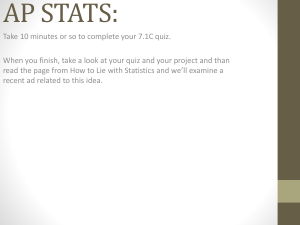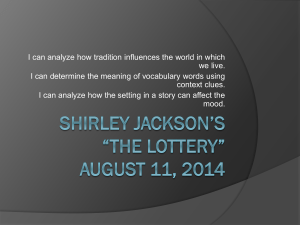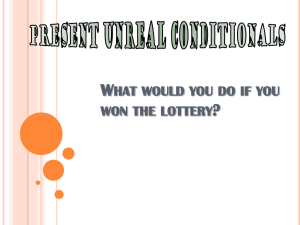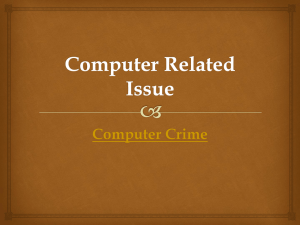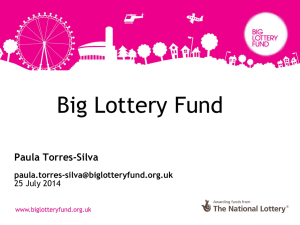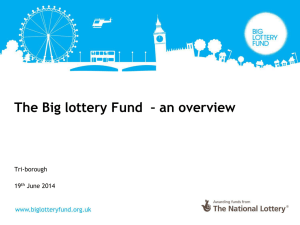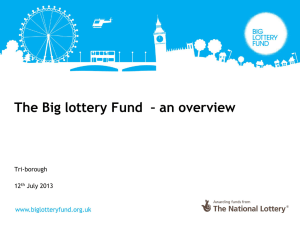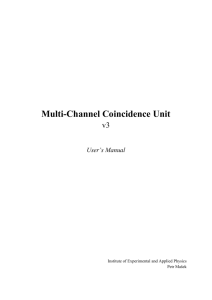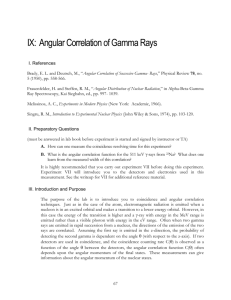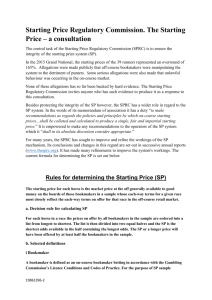Quizch18_key
advertisement
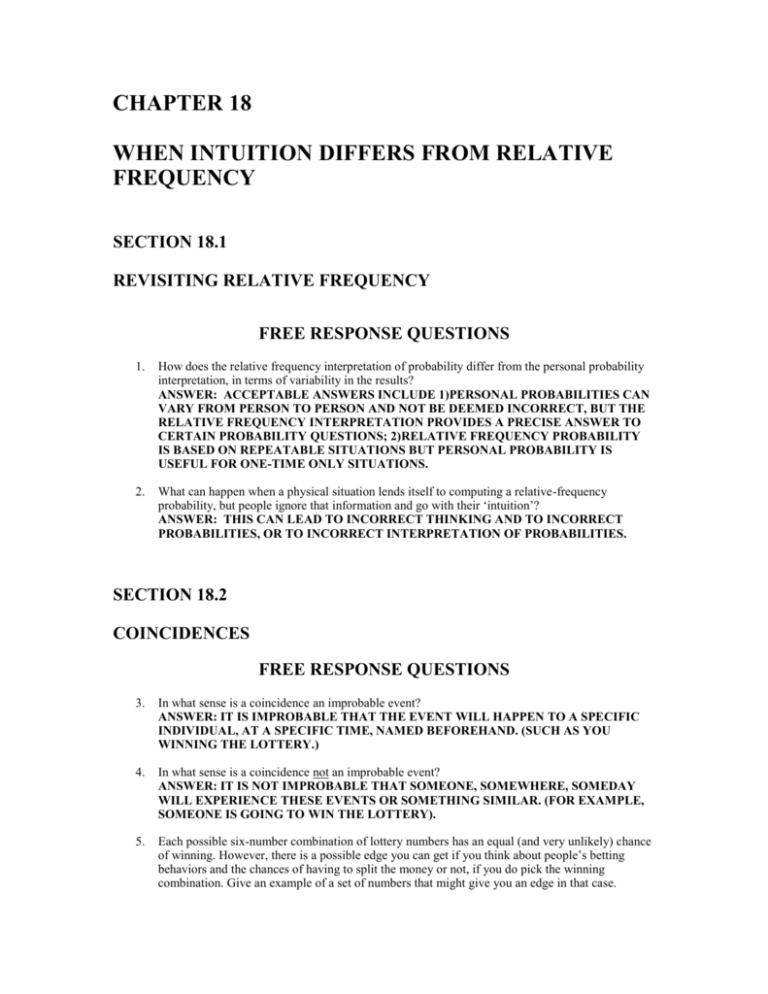
CHAPTER 18 WHEN INTUITION DIFFERS FROM RELATIVE FREQUENCY SECTION 18.1 REVISITING RELATIVE FREQUENCY FREE RESPONSE QUESTIONS 1. How does the relative frequency interpretation of probability differ from the personal probability interpretation, in terms of variability in the results? ANSWER: ACCEPTABLE ANSWERS INCLUDE 1)PERSONAL PROBABILITIES CAN VARY FROM PERSON TO PERSON AND NOT BE DEEMED INCORRECT, BUT THE RELATIVE FREQUENCY INTERPRETATION PROVIDES A PRECISE ANSWER TO CERTAIN PROBABILITY QUESTIONS; 2)RELATIVE FREQUENCY PROBABILITY IS BASED ON REPEATABLE SITUATIONS BUT PERSONAL PROBABILITY IS USEFUL FOR ONE-TIME ONLY SITUATIONS. 2. What can happen when a physical situation lends itself to computing a relative-frequency probability, but people ignore that information and go with their ‘intuition’? ANSWER: THIS CAN LEAD TO INCORRECT THINKING AND TO INCORRECT PROBABILITIES, OR TO INCORRECT INTERPRETATION OF PROBABILITIES. SECTION 18.2 COINCIDENCES FREE RESPONSE QUESTIONS 3. In what sense is a coincidence an improbable event? ANSWER: IT IS IMPROBABLE THAT THE EVENT WILL HAPPEN TO A SPECIFIC INDIVIDUAL, AT A SPECIFIC TIME, NAMED BEFOREHAND. (SUCH AS YOU WINNING THE LOTTERY.) 4. In what sense is a coincidence not an improbable event? ANSWER: IT IS NOT IMPROBABLE THAT SOMEONE, SOMEWHERE, SOMEDAY WILL EXPERIENCE THESE EVENTS OR SOMETHING SIMILAR. (FOR EXAMPLE, SOMEONE IS GOING TO WIN THE LOTTERY). 5. Each possible six-number combination of lottery numbers has an equal (and very unlikely) chance of winning. However, there is a possible edge you can get if you think about people’s betting behaviors and the chances of having to split the money or not, if you do pick the winning combination. Give an example of a set of numbers that might give you an edge in that case. ANSWER: PEOPLE TEND TO BET ON BIRTHDAYS, SO THE NUMBERS 1 TO 12 AND 1 TO 31 ARE MORE COMMON. PEOPLE ALSO TEND TO BET PATTERNED SEQUENCES SUCH AS 5, 10, 15, 20, 25, 30. SO IF YOU BET ON THESE AND WIN, YOUR CHANCES OF HAVING TO SPLIT THE JACKPOT WILL BE GREATER. 6. Explain how a misinterpretation of a coincidence could impact a town that is experiencing an unusually high rate of cancer, compared to the rest of the country. ANSWER: PEOPLE MAY AUTOMATICALLY THINK THERE IS SOMETHING WRONG WITH THE WATER, SOIL, AIR, OR A VARIETY OF THINGS, AND START TO PANIC, SUE COMPANIES, GET MEDIA ATTENTION, OR PRESSURE THE GOVERNMENT TO GET INVOLVED, ALL WITHOUT PROPER SUBSTANTIATION OF AN ACTUAL PROBLEM. ANY RARE EVENT IS GOING TO HAPPEN TO SOMEONE, SOMEWHERE, SOMETIME. MULTIPLE CHOICE QUESTIONS . 7. When you experience a coincidence, which of the following interpretations is appropriate? a. If an event has a million to one chance, it is expected to happen to 290 people in the U.S. in a given day, on average (because the U.S. population is 290 million). b. It is not unlikely that something surprising will happen to someone, somewhere, someday. c. There is a big difference between the probability of a rare event happening to someone somewhere, and the probability of a rare event happening to a specifically named individual. d. All of the above. ANSWER: D 8. About how many people would need to be gathered together to be at least 50% sure that two of them will share the same birthday (the same day of the year, not necessarily the same year)? a. 4 b. 23 c. 183 d. 2,300 or more ANSWER: B 9. Which of the following lottery combinations (6 numbers from 1-30, no repeats allowed) is the least likely to come up as a winning ticket? a. 2, 10, 23, 27, 30, 11 b. 1, 2, 3, 4, 5, 6 c. 11, 19, 14, 12, 17, 15 d. All of the above are equally unlikely. ANSWER: D 10. Which of the following coincidences reflects a truly improbable event, if interpreted properly? a. My next-door neighbor won the lottery! I was only one house away from becoming rich! b. Wow, what are the chances that I’d be on the same flight as Bill Cosby? Unbelievable! c. I heard there’s a guy in Pennsylvania who won the lottery twice; that lottery must be rigged. d. None of the above. ANSWER: D FILL-IN-THE-BLANK QUESTIONS 11. A(n) __________ is a surprising concurrence of events, perceived as meaningfully related, with no apparent causal connection. ANSWER: COINCIDENCE 12. The probability of a coincidence happening may be __________ than you think. ANSWER: LARGER SECTION 18.3 THE GAMBLER’S FALLACY FREE RESPONSE QUESTIONS 13. Which of the following sequences of six tosses of a fair coin is more likely (if either): HTHTTH, or HHHTTT? Explain your answer. ANSWER: THESE SEQUENCES ARE EQUALLY LIKELY BECAUSE THE COIN IS FAIR. 14. Do you agree with the following statement regarding sequences of tosses of a fair coin? Explain why or why not. “The sequence HHHHTH doesn’t represent the fairness of the coin, and therefore is not as likely to occur as sequences such as HTHTTH.” ANSWER: NO; EACH SEQUENCE OF 6 TOSSES OF A FAIR COIN IS EQUALLY LIKELY. LONG TERM RESULTS DON’T APPLY IN THE SHORT TERM. MULTIPLE CHOICE QUESTIONS . 15. Which of the following beliefs are examples of the gambler’s fallacy? a. Random events are self-correcting. (For example if you are losing, believing that your luck is about to turn around.) b. The long-run frequency of an event should apply in the short term as well. (For example, “He’s a 90% free throw shooter, and he’s already missed 2 out of 3 tonight. There’s no way he’s going to miss this next one.”) c. Knowledge of one event will help predict the next event, even though the events are independent. (For example, you may hear someone at the craps table saying to the person rolling the dice, “You’re on a roll! Don’t stop now!”) d. All of the above. ANSWER: D 16. In which of the following situations would the gambler’s fallacy not apply? a. When the events are not independent. b. When knowledge of one outcome affects the probability of the next one. c. Both a) and b). d. Neither a) nor b); the gambler’s fallacy holds whenever gambling is going on. That’s how casinos stay in business. ANSWER: C SECTION 18.4 CONFUSION OF THE INVERSE FREE RESPONSE QUESTIONS 17. Explain what it means for a test result to be a false positive. ANSWER: YOU DON’T HAVE THE DISEASE BUT THE TEST RESULTS CAME UP POSITIVE. 18. What two conditions cause a test to have a relatively high rate of false positives? ANSWER: 1) THE BASE RATE IS LOW; AND 2) THE TEST IS LESS THAN PERFECT. 19. What is meant by the ‘sensitivity’ of a test for a certain disease? ANSWER: THE PROPORTION OF PEOPLE WHO CORRECTLY TEST POSITIVE WHEN THEY ACTUALLY HAVE THE DISEASE. 20. What is meant by the ‘specificity’ of a test for a certain disease? ANSWER: THE PROPORTION OF PEOPLE WHO CORRECTLY TEST NEGATIVE WHEN THEY DON’T HAVE THE DISEASE. MULTIPLE CHOICE QUESTIONS . 21. Which of the following is needed in order to determine the probability of a positive test result being accurate? a. The base rate. b. The sensitivity of the test. c. The specificity of the test. d. All of the above. ANSWER: D 22. Which probability is larger for a randomly selected woman from the general population: The probability of having breast cancer given that the woman has a positive mammogram, or the probability of a positive mammogram given that the woman has breast cancer? a. The probability of having breast cancer given that the woman has a positive mammogram. b. The probability of a positive mammogram given that the woman has breast cancer. c. The probabilities are the same. d. Not enough information to tell. ANSWER: B 23. What is meant by a test result that is a false positive? a. You have the disease but the test results were negative. b. You don’t have the disease but the test results were positive. c. You test positive for a different disease than the one they thought you had. d. None of the above. ANSWER: B 24. Which of the following describes the ‘specificity’ of a test for a certain disease? a. The probability that you are likely to have a specific disease, without any knowledge of your test results. b. The proportion of people who correctly test positive when they actually have the disease. c. The proportion of people who correctly test negative when they don’t have the disease. d. All of the above. ANSWER: C FILL-IN-THE-BLANK QUESTIONS 25. The __________ of a test for a certain disease is the proportion of people who correctly test positive when they actually have the disease. ANSWER: SENSITIVITY 26. Research shows that people tend to “detect” patterns even where none exist, and to __________ the degree of clustering of outcomes in sports events, as in other sequential data (for example the chance of being on a shooting streak in basketball). ANSWER: OVERESTIMATE SECTION 18.5 USING EXPECTED VALUES TO MAKE WISE DECISIONS FREE RESPONSE QUESTIONS 27. If the bookmakers who run sports betting operations were to set fair odds, so that both the house and those placing bets had expected values of zero, then the probabilities for all of the players should sum to 1, but they don’t. Do they sum to a higher or lower value, and why? ANSWER: FOR THE BOOKMAKERS TO MAKE MONEY, THEY SET THE ODDS SO THAT THE PROBABILITIES OF ALL THE PLAYERS SUM TO A NUMBER GREATER THAN ONE. SINCE SO MANY PEOPLE WILL BE PLACING BETS, THE BOOKMAKERS’ WINNINGS SHOULD BE CLOSE TO THE EXPECTED VALUE SET BY THE ODDS. 28. Suppose a lottery game has a 1/1000 chance of winning for each ticket, and the prize is $1,000. How much should you be willing to pay for a ticket in order to have a positive expected value? ANSWER: LESS THAN ONE DOLLAR PER TICKET. MULTIPLE CHOICE QUESTIONS . 29. Which of the following problems can arise when intuition differs from relative frequency? a. Always thinking that a coincidence has a low chance of occurring. b. The gambler’s fallacy. c. Confusion of the inverse. d. All of the above. ANSWER: D 30. Which of the following would be true if people made decisions based on maximizing their expected monetary return? a. People wouldn’t buy lottery tickets. b. People wouldn’t buy insurance. c. People wouldn’t participate in sports betting. d. All of the above. ANSWER: D

